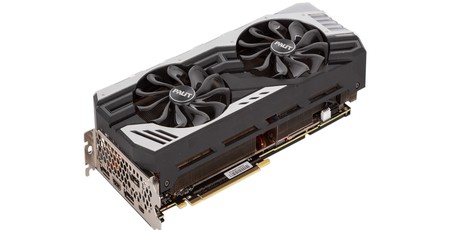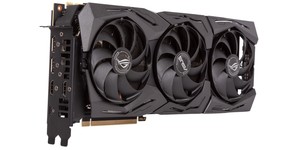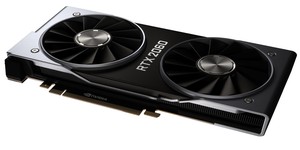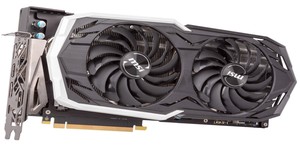Manufacturer: Palit
UK price (as reviewed): MSRP £799 (inc. VAT)
US price (as reviewed): Currently unavailable
While Nvidia has faced considerable backlash over the pricing of its Turing-based GeForce RTX 2080 Ti and RTX 2080 cards, few can deny the sheer quality of its latest Founders Edition cards. However, this puts board partners like Palit in a tough position - why opt for a third-party solution when the first-party offering is so good and, in most cases, the cheapest option. The RTX 2080 FE, for example, costs £750, and only a handful of SKUs tend to match or beat this price.

That hasn’t stopped Palit from offering a whopping six RTX 2080 SKUs, at least if its website is to be believed. Not all of them are easy to find stock of, including this one, the RTX 2080 Super JetStream, which is the second fastest in the Palit roster with a boost clock of 1,860MHz. This puts it at 60MHz/about three percent more than the FE and 150MHz/about nine percent faster than reference clocks. The 8GB of GDDR6 memory is left at the default speed of 14Gbps, which seems to be the norm.
The RTX 2080 Super JetStream is long, but not ridiculously so compared to what we’ve seen elsewhere at under 300mm. Where it stands out most is its thickness; at nearly 60mm deep it qualifies as a ‘2.7-slot’ card, thus making nearly full use of three expansion slots. It’s also tall at 130mm, meaning you’ll need to ensure you’ve adequate space for its protruding cooler and shroud, which is also long enough to overhang the PCB. With so much metal, Palit is clearly looking to excel when it comes to temperature and noise output, but something to note is that this beefy, heavy card does not come with an anti-sag mechanism of its own, which is a shame as it does indeed sag quite noticeably.

The rigid metal backplate is welcome, as is the metal cover on the plastic cooler shroud (though we wish it was exclusively metal), but certain bits of the shroud like the far end are easily depressed. Overall, it’s still a decent effort with regards to build quality, but we do wish there was a Founders Edition-style cover for the NVLink SLI connector.

The RTX 2080 Super JetStream appears to be power-hungry, as it’s rated with a 245W TDP, which exceeds the 225W TDP of the FE and 215W reference one; it does seem like Turing is less efficient than previous Nvidia architectures when pushing clock speeds up. Although a six-pin/eight-pin combination would still offer 300W, Palit has decided to upgrade the card to a dual eight-pin PCIe setup, raising total available power to 375W, which will easily cover any realistic overclock, even if using the VirtualLink VR USB-C header, which itself can add 35W not included in the TDP. It’s helpful that these connectors are indented too given how tall the card is. You also get one dual-six-pin to single-eight-pin PCIe adaptor in case your PSU doesn’t cut it, but it’s not braided.

The display connectors are the same as usual (three DisplayPort, one HDMI, one USB-C); there’s little reason we can see for board partners to change these.
The two-tone shroud is very colour-neutral, as is the highlighted black backplate. This makes sense, because RGB lighting is included on the front of the shroud along the top and at the far edge. Sadly, the ability to control this using the Palit ThuderMaster utility was disabled in the early version we used, but the default green was rather vibrant. It does mean we can’t comment on the quality of the lighting or effects overall, though.

The large heatsink relies on a copper baseplate to cool the RTX 2080 GPU and five copper heat pipes. These do have the preferred nickel plating, but they’re not very exposed, so the copper colour shouldn’t be a problem to most. The heat pipes feed two separate and very large aluminium fin stacks, and heat is also drawn directly away from the key power components and the memory modules via thermal padding. Overall, it appears to be a comprehensive cooling solution.
The heatsink is cooled by a pair of ~100mm fans with six-pole motors and 11 blades that conform to Palit’s TurboFan Blade 2.0 design. Oddly, when idle, monitoring programs like GPU-Z would report a 0 percent fan duty, suggesting that the card is semi-passive, but the fans still kept on spinning at about 800 RPM. At this speed you won’t hear them, but it’s still a shame they don’t switch off entirely.

The PCB design is clearly based on the reference one, but the extra height does give Palit some wiggle room, and it’s used this to upgrade the default 8+2 DrMOS power phases to 10+2, which isn’t a bad idea given the added speed and TDP. Another addition is a dual-BIOS switch right near the rear I/O panel.

The warranty terms for Palit end users depend on the retailer, which means you’re looking at a standard two years in the UK and EU. This is one year fewer than the Founders Edition card.
Specifications
- Graphics processor Nvidia GeForce RTX 2080, 1,515MHz (1,860MHz boost)
- Pipeline 2,944 stream processors, 368 Tensor Cores, 46 RT Cores, 184 texture units, 64 ROPs
- Memory 8GB GDDR6, 14Gbps effective
- Bandwidth 448GB/sec, 256-bit interface
- Compatibility DirectX 12, Vulcan, OpenGL 4.5
- Outputs 3 x DisplayPort 1.4a, 1 x HDMI 2.0b, 1 x USB-C VirtualLink
- Power connections 2 x eight-pin PCIe, top-mounted
- Size 292mm long, 130mm tall, 59.6mm deep ('2.7-slot')
- Warranty Two years

MSI MPG Velox 100R Chassis Review
October 14 2021 | 15:04









Want to comment? Please log in.